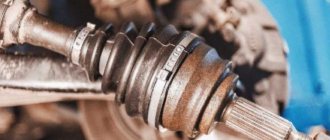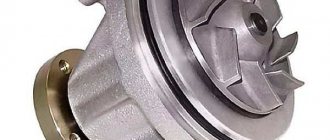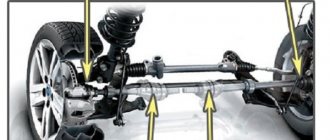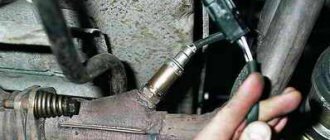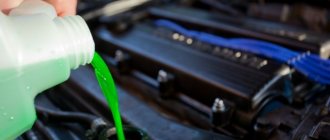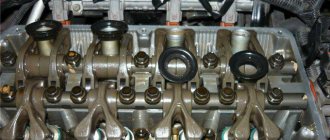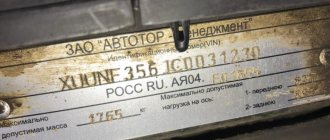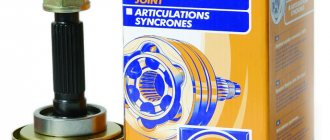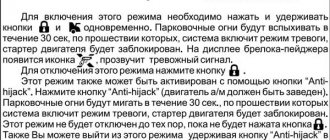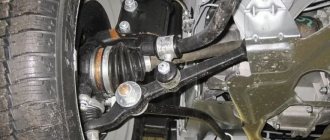Probably, many car enthusiasts have heard such a word as CV joint. When stopping at a service station, you can hear a lot of interesting words, but most drivers are afraid of a CV joint failure like fire. What kind of cunning device is this, and why its repair costs a pretty penny, we’ll find out in today’s article.
It is worth noting that literally fifty years ago, car enthusiasts had no idea about such an invention. CV joint is an abbreviation that stands for constant velocity joint. The principle of operation of the mechanism was used in Ancient Greece. Modern CV joints became widespread in the 50s of the last century.
What is a CV joint and why is it needed?
Location of external and internal CV joints
As a rule, in auto repair shops, professional craftsmen call the mechanism a “grenade”. All because of the appearance and complex design, vaguely reminiscent of a hand grenade. There is even a joke that every car has a “grenade” that will explode anyway.
CV joint (constant velocity joint) is a joint designed to transmit torque between shafts that are at an angle to each other. This is the main task. The design is installed on almost all modern cars. Without such a mechanism, it is impossible to transfer the momentum from the engine to the wheels, no matter the front or rear, without loss. It was with the advent of the CV joint that cars became more mobile and controllable.
CV joint solves many problems.
- Helps remove excess vibration.
- Synchronizes the rotation of the drive wheels.
- Reduces the load on the drive shaft while the vehicle is moving.
The transmission of motion is carried out at an angle between the front or rear axle shafts. The design is very useful, but if broken it can lead to expensive repairs. This is why many vehicle owners are even afraid to say the abbreviation out loud, so as not to cause trouble.
Troubleshooting CV joints
The CV joint is designed quite simply. Essentially, it is a set of bearings or balls moving in their own channels, but it is somewhat more difficult to repair. In any case, the car must drive, so the grenade needs to be repaired:
- If the boot is torn, then to replace it you need to disconnect the transmission mechanism from the gearbox or wheel hub.
- Disassemble the grenade and, using a removable device, remove the clip from the splines of the drive axis.
- Remove the boot and install a new one.
Work is carried out similarly to replace balls or the entire CV joint. When assembling, it is important to firmly place the boot in place and tighten the screws on the flange well when securing it.
What happens if you don’t change the CV joint of the drive?
If the car's chassis shows signs of malfunction in the form of a crunching sound or there are damaged anthers on the grenade, then you should not leave this problem for a better time. The defect should be eliminated promptly before even more serious damage occurs in the form of a chassis wedge or other problems. The cost of a grenade is much more than the cost of replacing the boot and lubricant in the mechanism.
Video of what can happen if you don’t change the CV joint boot in time
Respond to signs of CV joint failure in a timely manner, and then you won’t have to spend a lot of money on unexpected repairs to the car’s chassis. The video will tell you about all the possible problems that owners of front-wheel drive cars may have. The technician will also tell you how to repair this element of the machine. The latter will require special tools and a puller to remove the mechanism from the drive shaft.
How to extend the life of external and internal grenades
Any angular velocity joint, internal or external, requires periodic maintenance. It consists in timely detection of damage to the boot and its replacement. New lubrication and protection against dirt guarantee long, trouble-free operation. Also, do not forget that the CV joint is critical to strong vibration amplitudes and, when driving fast on an uneven road, can completely collapse. The greater the bend and the higher the rotation speed, the more its parts are under load, tending to break it and tear the hinges out of the channels. Also, driving on a sandy road will also make itself felt. If you are planning such a trip, then first examine the condition of the anthers and replace the torn one. Or immediately after a trip, since further driving without dust protection will lead to the CV joint breaking, and a new one is expensive. For example, an ASVA brand mechanism costs 3,180 rubles, and a Metelli kit will cost 4,100 rubles. Many craftsmen advise replacing standard clamps with steel clamps with screw clamps.
The design and principle of operation of the CV joint
Structure of external and internal CV joints: 1 - retaining ring of the inner joint housing;
2 — protective ring of the internal hinge; 3 — internal hinge body; 4 — shaft stop; 5 - retaining ring; 6 — clip; 7 - ball; 8 - thrust ring; 9 - separator; 10 - outer clamp; 11 — lock of the internal hinge; 12 — protective cover; 13 — internal clamp; 14 — wheel drive shaft (axle shaft); 15 — protective ring of the outer hinge; 16 — outer hinge housing. First of all, the hinge is designed to transmit driving force from the engine to the wheels of the car. The second important function is to maintain movement at different wheel planes. In simple words, when driving over a bump or hole, one of the wheels will be located higher than the second, while the movement of the car will remain unchanged. The complex design allows the wheels to move in different positions. The operating principle of each type of hinge is the same, only the design is different. The grenade can rotate at an angle of up to 70 degrees, while transmitting rotational motion to the wheels.
How does a CV joint work?
Most passenger cars use a “Rtseppa” type hinge (sometimes called a “six-ball”), consisting of an inner and outer race with grooves, a separator and six balls. This design works well even at high speeds and the wheels turned out to the maximum. Another type that has become widespread on some Japanese models is called “Tripod”. A three-rayed star is fixedly fixed in the tripod body, on which spherical rollers are mounted. The rotation of the hinge comes through a fork inserted into the body with spherical channels for the rollers. The disadvantage of a tripod is the small angle of change in the axis of rotation of the hinge, however, the possibility of axial movement allows them to be used as an internal CV joint.
Types and types of "grenades"
Structurally, the CV joint may differ. It all depends on the manufacturer and type. There are currently four main types of grenades.
- Cam
- Tripoid
- Ball
- Cardan paired
The cam consists of two round elements, one of which fits into the other. This design allows the application of maximum axle loads. Typically, vehicles equipped with a cam joint only travel at moderate speeds.
Cam CV joint device
Tripoid consists of three bearings. Most cars are equipped with this system. It is more versatile and quite rigid, capable of working at high speeds and lasts quite a long time.
Operation of a tripod CV joint
The ball-type system operates on the principle of a tripoid system, only instead of rollers, the torque is transmitted by small metal balls enclosed in a shell and moving along specified channels.
Operation of a ball CV joint
The universal joint consists of conventional universal joints that transmit torque to the wheels of the car. Installed on large trucks.
Operation of the universal joint
The history of the appearance of "Grenade"
The CV joint, popularly called the “Grenade,” is an element of the transmission of almost all front-wheel drive car models of our time. Despite this, the history of its design and appearance in the automotive industry is still shrouded in a certain veil of secrecy. Today, there are several versions of the creation of this node, among which the most plausible and partly confirmed stands out. According to available information, the CV joint was first designed by engineer Alfred Rzeppa back in 1927. This man worked for a long time, which resulted in the creation of a “grenade”, by the way, often called the Rzepp hinge.
Surprisingly, it took more than 40 years to update the created CV joint. This is largely due to the fact that only in the late 60s and early 70s of the last century did automakers begin to produce front-wheel drive cars with enviable regularity. The hinge in the design of the latter was of no small importance, namely, it neutralized the speed difference that arose when turning both the spinning and driven wheels. Without the use of “grenades” in the design of front-wheel drive vehicles, one would not even think about the comfortable and profitable operation of such units.
At first glance, it seems that the appearance of CV joints in the automotive industry is an unremarkable, ordinary event. However, in reality the situation is completely different, because the use of these hinges made it possible to make a real revolution in the concept of front-wheel drive cars. It’s not for nothing that they haven’t come up with anything better than ordinary, almost century-old “grenades.”
Malfunctions, signs and causes of breakdowns
Rupture of the CV joint boot
With normal driving and periodic checks, the joints can last for many years. From experience we can say that some CV joints work for 10-15 years without problems. The most common breakdown is wear of the boot. When the protective rubber breaks, dirt gets into the casing, the lubricant is washed out, and the system begins to malfunction.
In most cases, you can find out about a grenade failure while driving, as well as by ear. When dirt gets into the boot, the CV joint begins to make a specific noise when cornering. The sound is called "crunching". If you heard it once, it will be difficult to make a mistake. But it’s better not to hear it in your car! As a rule, a crunching noise signals the car owner about a lack of lubrication.
How to operate a car with a crunchy “grenade”
Many motorists are concerned about the question of how long they can drive with a faulty CV joint. If the breakdown occurs only when turning, the unit can be used for quite a long time. An important condition for its “reanimation” is replacing the lubricant and boot.
When making turns, you should maintain a low speed. If the inner CV joint is broken, it will take longer for it to finally fail than in the case of the outer one. When extraneous sounds occur when driving straight or do not disappear at all, replacement of the unit cannot be delayed. Such a hinge can completely break at any moment. This will make further movement impossible.
Advice for car owners
In order to avoid premature failure of the CV joint, it is recommended to periodically visit service stations and check the tightness of the outer protective casing. If there are any defects, it is better to replace the boot along with lubricant.
If the driver hears a characteristic crunching noise while turning, it is best to immediately contact a service station. The sooner the owner changes the boot and lubricants, the cheaper the repair will be. Undoubtedly, you can move around on a faulty “grenade” for a short period of time, but with great caution. The CV joint tends to get blocked in the direction of travel, it is better not to risk the lives of passengers and the driver!
It is worth noting that if you drive too aggressively, the mechanism fails much earlier than its lifespan. The service life can only be extended by safe driving and periodic checks of the condition of the boot.
In addition, I would like to say that not all car repair technicians can detect damage to the hinge by ear. There have been cases when a car owner, after listening to an unprofessional technician, bought an expensive part and ended up out of money, because the cause of the crunching noise could be other parts of the chassis. For example, a ball joint located on the front arms, if faulty, can make similar sounds when turning the wheel.
It is best to trust your car to trusted service stations with experienced technicians!
Replacing the outer CV joint
An experienced car owner with practical skills will not encounter any problems when taking on the task of replacing the outer CV joint. The list of tools necessary to carry out the “operation” has already been presented above. In addition to tools and supplies, there are a few other things worth doing. Before removing the wheel, drain a little oil from the gearbox - this will make it easier to work with. You will also need a pry bar - it will serve as a lever when removing the drive shaft.
Let's assume that the problem is on the right. Replacing the right CV joint begins with removing the wheel. We unscrew the hub nut, remove the brake disc, caliper, ball joint and steering tip. We take a pry bar or crowbar and remove the splined drive shaft. Using light blows of a hammer (a support, such as a wooden block, will come in handy), we knock out the outer hinge. Next we perform the following steps:
- It is necessary to remove the hub nut and tear off the wheel bolts. We put stops under the rear wheels.
- We jack up the car, hang it up and then remove the wheel.
- Remove the bolts holding the steering knuckle to the ball joint.
- Turn the steering wheel all the way. Pulling back the steering knuckle, we pull out the outer half of the hub along with the old CV joint. If the grenade does not budge, hit it lightly with a hammer.
- We remove the old boot and clamps and throw them in the trash.
- We remove the CV joint with hammer blows, rotating it along the axle shaft.
- We fix the installed new hinges in the hub together with the boot.
Replacing the left CV joint is carried out in the same way. When returning parts to their place, the above procedures should be done in reverse order. When knocking down a CV joint with a hammer, hit it clearly - some models are equipped with an ABS ring, which does not like strong blows to it. Don't forget to add gearbox oil. When installing the wheels back, be extremely careful to avoid falling apart.
Where is the grenade located in the car?
Let us repeat that this spare part is only available for front-wheel drive cars. Cars with rear drive wheels are driven by another shaft - a cardan. Therefore, the answer to the question of what a grenade is and where it is located in the car is relevant only for the first case.
The grenades are located in the front of the car. Each car contains 4 grenades: two per wheel. This is necessary so that the suspension can normally raise and lower the wheel on bumps and still steer. It is quite easy to identify them visually by their corrugated rubber boots.
Usually the anthers are black, but you can find brown-red or transparent models
The first grant in a pair is inserted into the wheel hub and is called the outer one. She is responsible for moving the wheel up and down and for turning it left and right. This unit experiences the heaviest loads, and therefore is manufactured in a fairly large size.
The second joint is inserted into the transmission and is called the inner joint. Its task is to ensure that the wheel moves slightly up and down on uneven surfaces. The load on it is less, and therefore the size is more modest.
The left joint is stuck into the wheel hub, and the right one into the gearbox output. Between them is the axle shaft
The outer and inner grenades are connected to each other by an axle shaft with longitudinal slots. It is this composite structure, consisting of three parts, that ensures the transmission of torque from the engine to the wheels.
Video about the CV joint, its disassembly and the reasons for the crunching
Video about the structure and principle of operation of the grenade
What lubricant to use for CV joints
The main tasks of lubricants used in CV joints are protection against friction and prevention of corrosion. Also, the lubricant must be inert with respect to the polymer boots, which prevent moisture and debris from entering the mechanism. Most of the above requirements meet the following types of lubricants:
1. Lithium. These are viscous yellowish compounds, which at low temperatures acquire an even thicker consistency, making it difficult to spread on parts. They are able to significantly reduce friction and loads acting on the hinge elements, protect them from moisture and neutralize accidentally trapped dirt. Their only drawback is the ability to dissolve some types of anthers made from organic polymers. One of the representatives of this type of lubricant is the domestic Litol-24, which is replaced after a run of 100 thousand km.
2. Based on molybdenum disulfide. More universal lubricants that are characterized by increased resistance to corrosion. Their composition has a reduced content of organic acids, thereby reducing aggressiveness towards polymer products. Such lubricants are recommended for use in CV joints of cars of any manufacturer. Their main drawback is sensitivity to moisture ingress when the seal of the boot is broken, due to which the lubricant loses its properties. Domestic manufacturers produce lubricants with molybdenum disulfide under the general name SHRUS-4.
3. Barium grease. It is resistant to moisture getting inside the mechanism, successfully resists corrosion, and is also neutral to any polymers from which the anthers are made. Its main drawback is poor resistance to low temperatures. Lubrication is currently not very common due to its high cost. All domestic compounds manufactured using this technology are labeled under the name ShRB-4.
To protect CV joints, even if recommended by sellers, it is not recommended to use the following compounds:
- Graphite lubricants, since they are designed to work in bearings, and when used in CV joints, its service life will not exceed 25 thousand km.
- Hydrocarbon lubricants, including technical petroleum jelly, are destroyed at temperatures exceeding 45°C and lead to hinge failure in a short time.
- Consistent compositions made on the basis of calcium and sodium, since they are not able to work in units with high mechanical loads, will lead to failure of the hinge after a run of 15-30 thousand km.
- Compositions made on the basis of zinc or iron.
When changing the joint lubricant, follow the operating instructions for the vehicle and the lubricant itself. Its scheduled replacement should be carried out every 100 thousand km, as well as when installing a new CV joint or boot.
Service life and maintenance
There are different types of CV joints, but they all have almost the same service life and maintenance methods. The grenade is considered a consumable item that requires periodic replacement.
The service life of a factory part depends on the following aspects:
Driving style.
Car brands.
Service time.
The first factor can be called decisive, since during aggressive driving the unit experiences heavy loads. With a quiet ride, the service life of the part is 100,000 miles.
It is also important to undergo timely maintenance, inspection of boots and lubricant filling. If the rubber parts crack, the CV joint will fail completely within 14 days. If moisture gets in, this process will happen even faster, as the water will wash away the lubricant.
You can extend the life of a grenade by fulfilling only two conditions:
Do not press too hard on the gas when starting or turning.
Change the grease with anthers.
The outer CV joint, unlike the inner one, experiences more loads, so it makes itself felt more often.
As for lubricant, there are rules for replacing it. It changes in the following cases:
While replacing the boot.
If the boot has been damaged.
If the CV joint has been in use for more than 5 years.
The car has covered over 100 thousand km.
There is no need to think that the more lubricant is applied, the better. This rule works in reverse.
Tools and accessories
To carry out the work, you will need a standard set of tools - open-end wrenches, ring wrenches, and socket wrenches. Screwdrivers, jacks, pliers - these are all things that everyone should have in their garage. But special tools are also needed. For example, pullers for steering tips. If you are simultaneously changing the ball joint, it also needs a puller. But if you only intend to replace the inner CV joint (left or right), then these tools will not be required.
It is worth noting that for repairs you need another wrench - 30. It is with its help that you need to unscrew the nut on the hub. It is desirable that this wrench have a large lever, since the nut is tightened with a very large torque. You also need wheel chocks for the rear wheels to prevent the car from moving. Having reliable supports is also necessary. And most importantly - a strong vice.
Removing the drive
To remove the drive from the car, you will need to perform a few more simple steps:
- Remove the cotter pin from the tie rod end by straightening it using pliers.
- Using a 19mm wrench, unscrew the nut. If it doesn't budge, treat it with a penetrating lubricant and try again in a few minutes.
- Install the puller onto the steering knuckle and rotate the main bolt clockwise. Tap with a hammer if necessary. After a few turns, the finger should come out of the fist.
- Remove the two bolts that secure the ball joint to the front wheel hub.
- That's practically all, all that remains is to knock out the front left (inner) CV joint with light taps, and only after that - the outer one.
Preparation for repair
Before starting work, you need to prepare the entire set of spare parts:
- Directly CV joint.
- CV boot.
- Two clamps.
- Graphite based lubricant.
- Hub nut.
Only after this can you begin to carry out repairs. First of all, drain the oil from the gearbox. It is advisable to drain everything, it will be easier. In fact, it is enough to pour out 2/3 of the total volume. In this case, when removing the hinge, oil will not spill from the holes. Place chocks under the rear wheels. Then, using a hammer and a suitable drift, unlock the nut, unscrew it, lift the side to be repaired and remove the wheel.
Design resource
To be honest, the design is very durable. If everything is done according to the rules and from the right materials (not underground “CHINESE”), then the CV joint can last at least 100,000 kilometers, and at most the entire service life of the car. But why do they fail so often? Everything is quite simple here!
1) The most common failure is a break in the boot. The thing is that the boot (rubber or silicone cover) protects the balls and grooves from dirt and dust, which have a very detrimental effect on the design. If the boot is torn, then the “GRANATE” will not serve you for long, literally just a couple of thousand kilometers. Why is this happening? And here everything is simple - dust and dirt act on the balls and longitudinal grooves like an abrasive, they destroy the grooves, making them wider, and at one point the balls simply jam. The CV joint can simply break. Therefore, if this “cover” is torn, we definitely change it.
2) These are physical impacts on the suspension. You can run into a curb or fall into a hole, and severely damage the suspension and the GRENADES themselves; they can simply be torn out. Look what happens if you use low-quality Chinese parts.
Identifying a broken CV joint is not that difficult, but there is a separate article , where I described everything point by point, so go ahead and read the useful information.
This is where I will end my article, I think I explained in detail what it is and how it all works, if you liked the article, tell your friends about us on social media. networks. Read our AUTOBLOG.
Similar news
- What is VAG? We study the intricacies of German business
- What is engine torque
- DOHC engine
Add a comment Cancel reply
What does a car's front-wheel drive look like and what parts does it consist of?
The top photo shows a car's front-wheel drive assembly. At the ends of the drive there are grenades (constant velocity joints - CV joints). On the left is an external grenade, on the right is an internal one. The inner CV joint is stuck into the box, and the outer one into the hub. The function of the drive is to transmit torque to the car wheel.
This is interesting: What relates to the chassis
Structure
As you understand, we will consider the ball CV joint, because the others are practically not used in construction (I don’t presume to be responsible for all brands). The structure is “dry”; the structural elements are not in oil (like the rear axle), they only have a slight lubricant. This device may seem complicated, but everything is simpler than it seems at first glance.
This unit has only 4 main parts:
1) Housing - made in the shape of a spherical bowl into which the driven shaft is installed.
2) The lower part is a spherical cam with a drive shaft.
3) Separator - made in the shape of a ring with holes where the balls are located and held.
4) Metal balls - there are six of them in the design, hence the name “ball”.
Such a simple structure is highly smooth; the car can reach speed smoothly without any jolts. If you compare it with a universal joint, there is no such smoothness.
How to replace a grant
The first question: “should I change it myself or at a service center?”
In principle, for most budget cars (VAZ, Chevrolet, Hyundai, etc.), if you have experience in repairing the vehicle's chassis and tools, replacing the hinge is not that difficult. You can even do without a hole. But you will have to sweat.
Typically, it is precisely these spare parts that make up a kit for replacing a grenade in a store: boot, lubricant, grenade, boot clamps, retaining ring for the axle shaft
For expensive cars, without experience and tools, for cars under warranty or insurance - definitely the way to service.
The second thing that car enthusiasts often encounter is the locksmith’s phrase “if one grenade crackles, then both need to be changed at once.” Moreover, some insist on replacing the external-internal pair. Others persuade you, when one of the outer ones cracks, to replace the second one and leave the inner ones.
The motivation is simple: if one part is broken, then the second one will soon fit. You decide. And although we have already said more than once that the consumables are inexpensive, but with a mass replacement, the repair will cost a pretty penny.
But no one can know when the working joints “crack”. And practice shows that they can travel for more than one thousand kilometers.
Therefore, answering the question “do both grants need to be changed?” We think it's not worth it. Let the details finish in due time and save your budget. Moreover, before the “explosion”, the grenade itself will warn you in advance with light clicking sounds.
Video about replacing a grenade on a VAZ 2108, 2109, 21099
